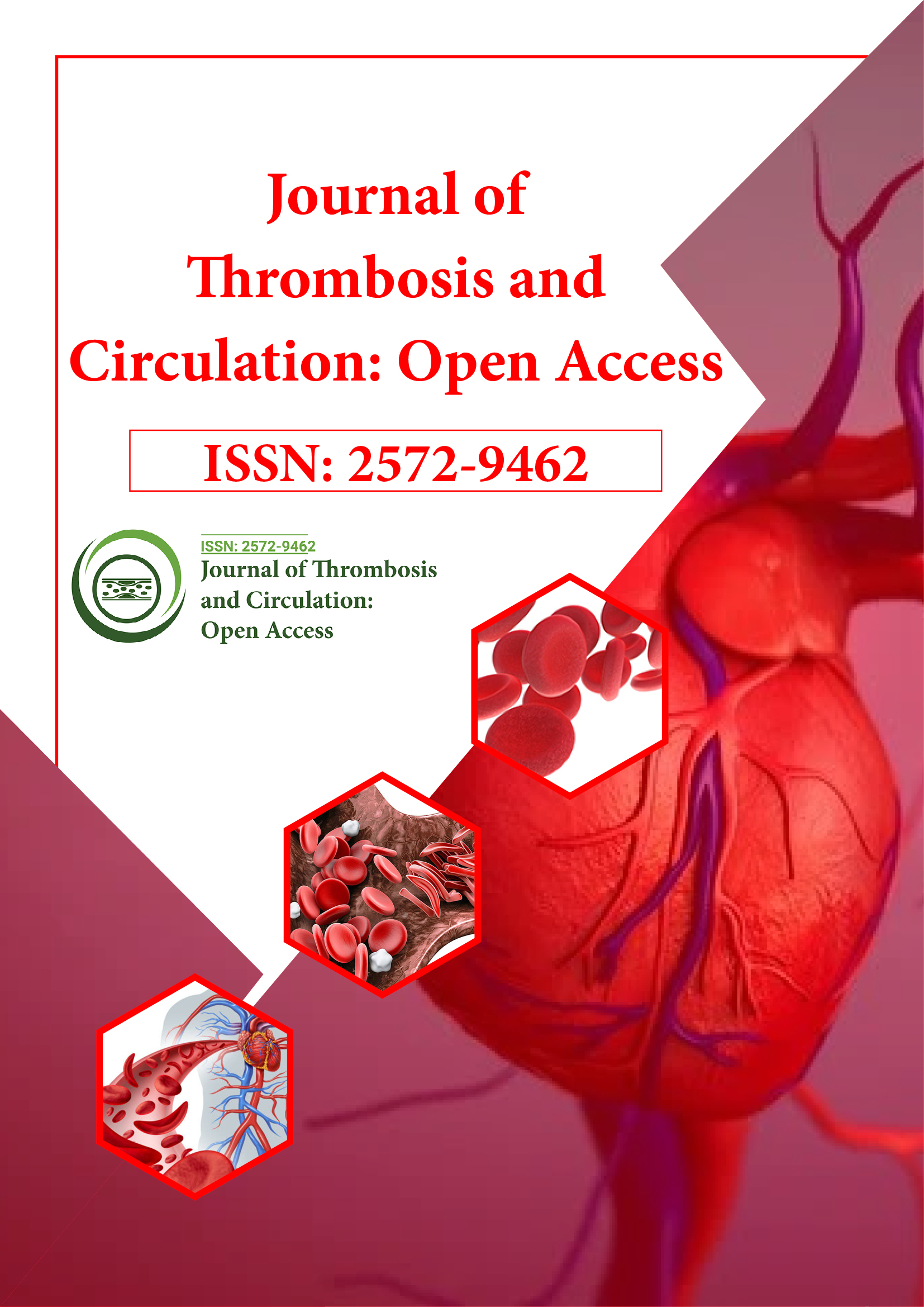Indexed In
- RefSeek
- Hamdard University
- EBSCO A-Z
- Publons
- Google Scholar
Useful Links
Share This Page
Journal Flyer

Open Access Journals
- Agri and Aquaculture
- Biochemistry
- Bioinformatics & Systems Biology
- Business & Management
- Chemistry
- Clinical Sciences
- Engineering
- Food & Nutrition
- General Science
- Genetics & Molecular Biology
- Immunology & Microbiology
- Medical Sciences
- Neuroscience & Psychology
- Nursing & Health Care
- Pharmaceutical Sciences
Mini Review - (2021) Volume 7, Issue 4
The Hypercoagulable State in COVID-19
Jessica Grace*Received: 10-Jul-2021 Published: 31-Jul-2021, DOI: 10.35248/2572-9462.21.7.165
Introduction
The tale Covid, serious intense respiratory disorder Covid 2 (SARS-CoV-2), arose in Wuhan, China toward the finish of 2019 and is currently a pandemic. The illness it causes, Covid sickness 2019 (COVID-19), has influenced in excess of 7 million individuals worldwide and asserted in excess of 400,000 lives as of June 2020. The sickness goes from asymptomatic or gentle to serious ailment with multi-organ disappointment and passing. Coagulopathy, as venous and blood vessel thromboembolism, is arising as perhaps the most serious continuation of the infection, and has been prognostic of more unfortunate results. Reports of high frequency of apoplexy regardless of prophylactic and helpful portion anticoagulation bring up issue about a pathophysiology novel to COVID-19. Seriously increased incendiary reaction that prompts thrombo-aggravation, through components, for example, cytokine storm, supplement enactment, and endotheliitis. It has additionally been recommended that the actual infection can actuate the coagulation course. Unmistakably patients with COVID-19 disease have an essentially expanded danger of apoplexy that wins in spite of anticoagulation [1].
Pneumonic embolism is the most well-known thrombotic sign of COVID-19. One of the first generous datasets on hazard of venous thromboembolism (VTE) in fundamentally sick patients with COVID-19, revealed a VTE frequency of 25%. Notwithstanding bedside proof for a hypercoagulable state in COVID-19, lab tests have likewise been steady with a prothrombotic milieu like expanded D-dimer, fibrinogen, factor VIII (FVIII), von Willebrand factor (vWF), diminished antithrombin, and TEG results. Coronavirus causes a significantly favorable to incendiary state, as apparent from different reports of high C-responsive protein, lactate dehydrogenase, ferritin, interleukin-6 and D-dimer levels. IL-6 and fibrinogen levels are displayed to connect with one another in COVID-19 patients, giving assurance to the possibility of incendiary apoplexy. The cytokine profiles in patients with serious COVID-19 show expanded creation of IL-6, IL-7, TNF, and fiery chemokine's like CCL2, CCL3, and solvent IL-2 receptor, a profile like that found in cytokine discharge conditions, for example, macrophage enactment disorder. Unnecessary cytokine discharge adds to apoplexy through various systems, including enactment of monocytes, neutrophils, and the endothelium, all of which creates a prothrombotic state [2]. The part for MNPs in the age of extreme ailment, including potentially the prothrombotic sequelae. This isn't shocking given the arrangement that actuated monocytes quickly up direct tissue factor (TF) articulation. This triggers the coagulation course bringing about creation of thrombin which thusly prompts blood clot age, platelet actuation, and intensification of supportive of incendiary pathways, essentially through PAR flagging. Expected components of lymphocytopenia may incorporate direct contamination of the lymphocytes by the infection, however the extent of ACE2-positive lymphocytes is minuscule. Lymphocytes express the Covid receptor Angiotensin changing over protein (ACE2) and might be straightforwardly designated.
Higher portions (moderate or remedial) of anticoagulation in the administration of patients with serious COVID-19, particularly without clear contraindications like continuous dying. Notwithstanding, they likewise infer, the worry that anticoagulation in itself might be deficient to forestall thrombotic confusions. There has been interest in the utilization of against fibrinolytics in the administration of apoplexy and ARDS in the setting of COVID-19. In spite of the fact that restraining thrombin age with heparin specialists may forestall further fibrin statement, not at all like the utilization of hostile to fibrinolytics, it's anything but successful against prior fibrin stores. The utilization of tPA to treat ARDS in COVID-19 has been proposed, following a case series of 3 COVID-19 patients in whom tPA was related with impermanent improvement in respiratory boundaries. The utilization of nebulized streptokinase in patients with serious ARDS brought about upgrades in oxygenation and lung mechanics more quickly than nebulized heparin. Another specialist with fibrinolytic properties that has been considered is Nafamostat. Nafamostat has both enemy of fibrinolytic movement just as hostile to viral action, and has in this manner produced keen on being repurposed as an expected helpful specialist for COVID-19 in continuous examinations [3].
The hypercoagulable state in COVID-19 is arising as a significant neurotic event with genuine results in mortality and dismalness. Obviously this insanity in the hemostatic pathways is not normal for the one seen in different sorts of disease, sepsis, or ARDS. Strikingly, current reports indiciate clinical appearances of both inescapable microvascular just as enormous vessel apoplexy. A superior comprehension of this pathophysiology will consider the advancement of suitable remedial modalities. Moreover, the recognizable proof of biomarkers of apoplexy and serious ailment can direct clinicians on early interventional systems and center medical services assets towards the gathering of patients in danger for more awful results.
REFERENCES
- Zhu H., Wei L., Niu P. Glob Health Res Policy. 2020. The novel coronavirus outbreak in Wuhan, China.
- Emami A. Prevalence of underlying diseases in hospitalized patients with COVID-19: a systematic review and meta-analysis. Arch Acad Emerg Med. 2020; 8(1):35.
- Yi Y. COVID-19: what has been learned and to be learned about the novel coronavirus disease. Int J Biol Sci. 2020:1753–1766
Citation: Grace J (2021) The Hypercoagulable State in COVID-19 J Thrombo Cir. 7:165. 10.35248/2572-9462.7.165.
Copyright: �?�©2021 Grace J. This is an open-access article distributed under the terms of the Creative Commons Attribution License, which permits unrestricted use, distribution, and reproduction in any medium, provided the original author and source are credited.
